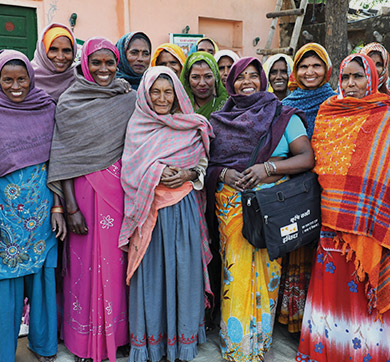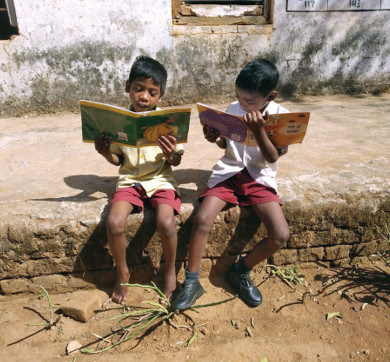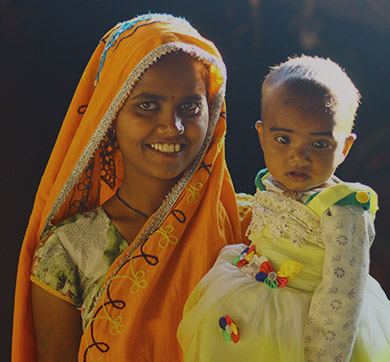June 2020 | 1274 words | 5-minute read
It’s story time and as 48-year-old Chetna Vishwa takes a group of second graders through the lion-and-mouse fable, the children happily yell answers in Hindi. They know this tale well and that’s surprising — because the children belong to the Grasiya tribe and Hindi is not their mother tongue.
Ms Vishwa teaches at the Government Senior Secondary School in Sivaya in Rajasthan’s Sirohi district. This is what the NITI Aayog, the central government think tank, calls an ‘aspirational’ district, which means districts which show slower socioeconomic progress and, hence, require policy attention in areas such as education.
In 2015, when the Tata Trusts planned education interventions in the area, they focused on capacity building, developing teaching-learning material and technology to improve the education experience for thousands of young minds in more than 250 schools in tribal villages of Sirohi and Pali.

The biggest impediment was the language barrier. Grasiya is the main language spoken by the tribals but the textbooks and teaching material were in Hindi. “We realised that teachers were struggling because the existing textbooks made little sense to the children,” says Vijay Singh, general manager of Centre for microFinance (CmF), an associate agency of the Trusts.
The children found the material almost alien. “They had no exposure to other languages or cultures, not even through media such as television,” says Vineet Panwar, CmF’s programme manager for education. The teachers had stopped trying, deeming the children too slow to learn. There was no parental pressure as most of the kids are first-generation learners. Instead of sending their children to school, parents would send them to gather wood for cooking or to look after their goats.
It took more than three years for the Trusts to develop new teaching-learning material. These had illustrations that mimic local culture and use a vocabulary that comprises Grasiya and Hindi. For example, the children first read rupru, the Grasiya word for tree, before they learn the Hindi equivalents ped and jhad.
Effective learning
The newly designed material for Hindi and maths for Stds I to V has proved to be remarkably effective. This has been affirmed by the external learning assessment conducted as part of the programme. Std II students at CmF’s project schools in Abu Road and Pindwara subdivisions exhibited higher levels of comprehension (28% and 45% respectively) when compared with non-project schools (2.7%).
CmF also conducts teacher training workshops on the new resource material and sensitises teachers on building a rapport with the children. The interventions are delivering visible results. “Teachers now see that the same children they had written off earlier are picking up reading and writing skills,” says Mr Panwar.
Besides better learning outcomes, there have been other benefits too. Children are less distracted in class, more curious and more regular in attending school. “They now ‘listen’ to our teaching; for the first time, I see them interested in learning new things,” says Ms Vishwa. “The other day, my standard V students asked me to teach them English. I was touched.”
When 14-year-old Amiya Kumari picks up a textbook and starts to read fluently, it’s a happy story at several levels. First for Amiya, who had not had a day of schooling in her life until age 10, when she joined the KGBV residential school at Girwar, 65km south of Sirohi town. (KGBV stands for Kasturba Gandhi Balika Vidyalaya and is a pan-India residential school programme run by the central government for girl children. There are 200 such schools in Rajasthan.)
At the Girwar school, where 108 girls study, Amiya’s success serves as a beacon for other girl students. Hailing from poor backgrounds, many of them are former school dropouts who are starting afresh in the system.
A load of help
CmF also conducts teacher training workshops on the new resource material and sensitises teachers on building a rapport with the children. The interventions are delivering visible results. “Teachers now see that the same children they had written off earlier are picking up reading and writing skills,” says Mr Panwar.
Besides better learning outcomes, there have been other benefits too. Children are less distracted in class, more curious and more regular in attending school. “They now ‘listen’ to our teaching; for the first time, I see them interested in learning new things,” says Ms Vishwa. “The other day, my standard V students asked me to teach them English. I was touched.”
When 14-year-old Amiya Kumari picks up a textbook and starts to read fluently, it’s a happy story at several levels. First for Amiya, who had not had a day of schooling in her life until age 10, when she joined the KGBV residential school at Girwar, 65km south of Sirohi town. (KGBV stands for Kasturba Gandhi Balika Vidyalaya and is a pan-India residential school programme run by the central government for girl children. There are 200 such schools in Rajasthan.)
At the Girwar school, where 108 girls study, Amiya’s success serves as a beacon for other girl students. Hailing from poor backgrounds, many of them are former school dropouts who are starting afresh in the system.
Anganwadi advantage
Ms Nani echoes other mothers when she says that the four hours the kids attend the anganwadi has a deep impact: “The children who attend are well adjusted and happy when they start primary school.” CmF’s anganwadi intervention has critical significance from both an education perspective and an overall developmental perspective, as getting the right developmental inputs at a young age is a big step on the road to education.
As a part of its education intervention, CmF and the Trusts are engaged in several aspects of the knowledge chain, from working with education department officials and training anganwadi workers, teachers and principals to designing teaching resources. In Sirohi, CmF has taken a step further to make the community see the school as a common asset.
“We realised the need to make the community an important stakeholder in school management,” says Mr Singh. The Nichlagarh Government Senior Secondary School has 16 members in the school management committee (SMC). They meet every month to discuss issues that are important to the school’s functioning: are the teachers attending, do the children get their proper quota of milk and the midday meal, is the drinking water safe and, how are school funds being used?
Nana Ram, the SMC vice president, is one of the more engaged parents. “When the school needed a water filter, we villagers got together and contributed,” he says. “When a schoolteacher was maltreating the children, we reported him. When children drop out of school to help with farm labour, we convince the parents to send them back to class.”
Developing the SMCs is a focus area for Bodh Shiksha Samiti, one of CmF’s education implementation partners. Programme coordinator Bhagchand Balai explains that about 300 SMC members across 60 schools have been given a one-day training on processes and responsibilities. “The training shows them how to monitor school activities, oversee the school budget, keep minutes of meetings, and other aspects,” he explains.
The training builds a much-needed bridge between the school and the community, and it is much appreciated by the SMC members, many of whom are school dropouts. Dhuli Bai, who runs a flour mill, is one of the women members on the committee. Asked why she joined, she says, “Because education is important. All the kids should go to school.”
That simple statement underscores the significance of CmF’s education interventions. But with 30% of the children here still out of school, it is clear that CmF’s work is far from done.
—Gayatri Kamath
Photographs courtesy Ravi Kant
Source: Tata Trusts' Horizons, April 2020 issue



